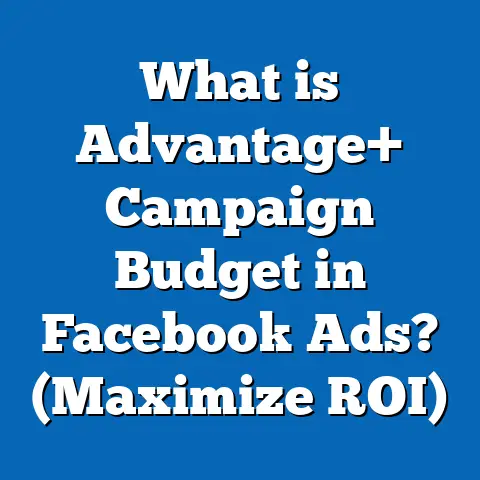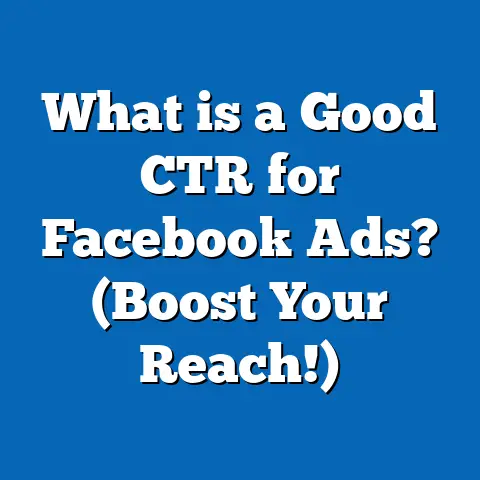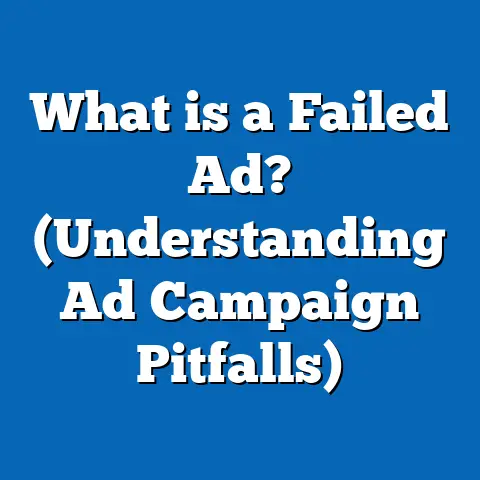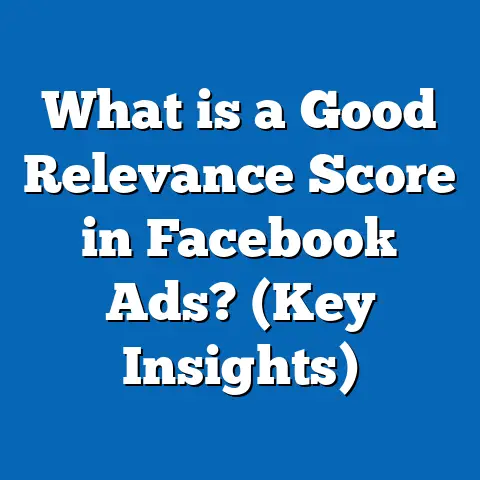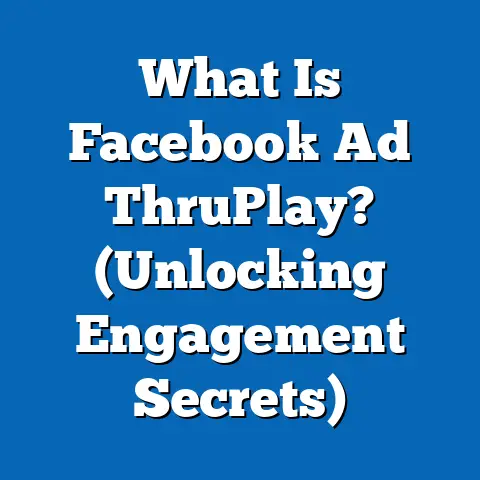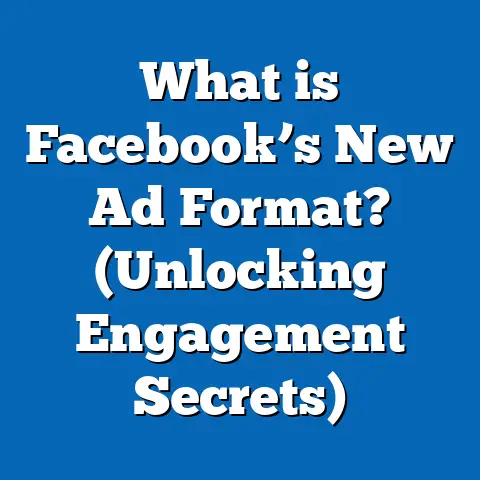What is More Effective: Facebook Ads or Twitter Ads? (Find Out!)
Introduction: The Power of Layering in Social Media Advertising
In today’s highly competitive digital landscape, layering marketing strategies is essential to maximize campaign effectiveness. Layering means combining multiple advertising tactics and platforms to reinforce your brand message and reach your target audience in various ways. Social media advertising is no exception. Among the many platforms available, Facebook and Twitter remain two of the most important players for marketers worldwide.
Facebook Ads and Twitter Ads both offer unique opportunities but also come with distinct strengths and limitations. Facebook’s massive user base and sophisticated targeting provide broad reach and precision, while Twitter’s real-time engagement and conversational nature create dynamic opportunities to connect with audiences during trending moments.
Understanding Facebook Ads and Twitter Ads: The Basics
Facebook Ads Overview
Facebook remains the largest social media platform globally, with an ecosystem that extends beyond Facebook itself to Instagram, Messenger, and WhatsApp. This interconnected network provides advertisers with unparalleled access to diverse audiences.
- Audience Size: Over 2.96 billion monthly active users worldwide (Q1 2024).
- Demographic Breadth: Users range from teenagers to seniors, across all major global markets.
- Ad Formats: Includes image ads, video ads, carousel ads, collection ads for ecommerce, lead generation ads, dynamic product ads, and more.
- Targeting Capabilities: Facebook offers granular targeting based on demographics (age, gender, education), interests (hobbies, brands), behaviors (purchase history, device usage), location (down to zip code), and custom audiences (uploading customer lists or website visitors).
- Campaign Objectives: Choose from awareness, traffic, engagement, app installs, video views, lead generation, conversions, catalog sales, store visits.
- Ad Placement Options: Ads can appear in Facebook feeds, Instagram feeds & stories, Messenger inbox, audience network (third-party apps), and in-stream videos.
Twitter Ads Overview
Twitter plays a distinct role as a platform centered around real-time conversation and news sharing. It attracts users looking for live updates on events and trending topics.
- Audience Size: Approximately 450 million monthly active users globally.
- Demographic Focus: Heavily skewed toward younger users aged 18-29; strong presence among professionals interested in tech, news, politics.
- Ad Formats: Promoted tweets to boost specific posts; promoted accounts to increase followers; promoted trends to feature hashtags; video ads; carousel ads with swipeable images.
- Targeting Capabilities: Target by tweet keywords (contextual targeting), interests derived from user behavior, follower look-alikes, demographics such as location/age/gender/device type.
- Campaign Objectives: Brand awareness, tweet engagements (likes/retweets/replies), follower growth, website clicks/conversions, app installs.
- Ad Placement: Primarily within user timelines and search results; promoted trends appear at the top of trending topics.
Audience Reach and Engagement: Who’s More Effective?
Facebook: Massive Reach with Diverse Demographics
Facebook’s unparalleled scale allows advertisers to reach almost any demographic segment globally. According to Pew Research Center (2023):
- Usage Penetration: 69% of U.S. adults use Facebook.
- Age Distribution: Strongest user group is 25-34 years old (32% of users).
- Business Presence: Over 75 million active business Pages.
- Average Time Spent: Users spend about 30 minutes daily on the platform.
Engagement Metrics:
- Average click-through rate (CTR) across industries is around 0.90%.
- Video ads increase engagement significantly—up to 5 times more than static images.
- Facebook’s algorithm favors relevant ads with higher engagement scores.
Implications for Marketers:
The platform’s size means you can reach broad or niche audiences effectively. Its high engagement potential makes it ideal for campaigns focused on awareness and conversions.
Twitter: Real-Time Engagement with Niche Audiences
Twitter boasts a smaller but highly engaged user base that thrives on current conversations:
- Usage Penetration: 38% of U.S. adults use Twitter.
- Age Skew: 44% of users are aged 18-29.
- Daily Usage: 42% log in daily.
Engagement Metrics:
- Twitter ads average a CTR of about 1.2%, slightly higher than Facebook.
- Tweets using hashtags double engagement rates.
- Real-time conversations create viral amplification opportunities.
Implications for Marketers:
Twitter is best suited for brands wanting to join trending conversations or launch time-sensitive campaigns. It appeals particularly to tech-savvy and news-focused audiences.
Targeting Precision: How Do Facebook and Twitter Compare?
Facebook’s Advanced Targeting
Facebook’s targeting strength lies in the depth of its data:
- Custom Audiences: Upload customer lists or website visitor data for retargeting.
- Lookalike Audiences: Automatically find new users similar to your best customers.
- Detailed Demographic Filters: Age, gender, education level, relationship status.
- Interest & Behavior Data: Interests can be narrowed down to thousands of categories; behaviors include online shopping habits and travel tendencies.
- Location Targeting: Country-level down to city or zip code precision.
Effectiveness:
These options allow advertisers to deliver personalized messages that resonate deeply—improving ad relevance scores and reducing wasted impressions.
Twitter’s Contextual Targeting
Twitter’s targeting centers around context rather than deep personal data:
- Keyword Targeting: Place ads alongside tweets containing specific words/phrases.
- Interest Targeting: Based on user tweet activity and profile information.
- Follower Look-Alike Targeting: Reach similar audiences to specific account followers.
- Tailored Audiences: Custom lists of email addresses or website visitors.
Effectiveness:
This approach leverages the real-time nature of Twitter but provides less granular audience segmentation compared to Facebook.
Ad Formats and Creatives: Which Platform Offers More Flexibility?
Facebook’s Diverse Ad Formats
Facebook supports a wide range of ad formats tailored for different marketing objectives:
- Image Ads: Simple but effective visuals paired with targeted text.
- Video Ads: Short clips designed to capture attention quickly; auto-play enhances visibility.
- Carousel Ads: Multiple images/videos in one ad unit users can swipe through.
- Collection Ads: Mobile-first ads combining images/videos with product catalogs for seamless shopping experiences.
- Lead Generation Ads: Capture user information without leaving Facebook via instant forms.
- Dynamic Product Ads: Automatically show personalized product recommendations based on past behavior.
- Playable Ads (for apps): Interactive ads that let users try a mini-version of an app before downloading.
Twitter’s Focused Ad Formats
Twitter offers fewer but highly engaging ad types:
- Promoted Tweets: Amplify individual tweets to wider audiences.
- Promoted Accounts: Increase followers by highlighting your profile.
- Promoted Trends: Feature branded hashtags at the top of trending lists for massive visibility during key events.
- Video Ads: Auto-play embedded videos that engage users during scrolling.
- Carousel Ads: Swipeable cards within tweets showcasing multiple products or messages.
Cost Efficiency: Budgeting for Maximum ROI
Facebook Ads Cost Analysis
Facebook’s cost structure varies by industry but generally remains affordable:
- Average CPC ranges between $0.50 and $2.00 across sectors.
- CPM averages $7-$12 but can fluctuate based on targeting precision and competition.
Factors Influencing Costs:
- Higher ad relevance scores reduce CPC by improving auction outcomes.
- Narrower targeting increases cost per impression but improves conversion likelihood.
- Seasonality affects costs—holiday periods tend to see spikes.
Twitter Ads Cost Analysis
Twitter ads typically have higher CPCs due to smaller audience size and auction bidding dynamics:
- CPC can range from $0.50 up to $4.00 depending on competition.
- CPM generally falls between $6-$10.
Cost Drivers:
- Real-time trending topics can cause cost spikes due to increased demand.
- Niche targeting often results in higher CPC but better engagement quality.
Performance Metrics: Measuring Success on Facebook vs Twitter
Key Metrics on Facebook
- Click-Through Rate (CTR): Percentage of people clicking your ad after seeing it; industry average ~0.90%.
- Conversion Rate: Percentage completing desired actions like purchases or sign-ups; varies widely by sector.
- Relevance Score/Quality Ranking: A score from 1–10 indicating how well your ad matches target audience interests; higher scores lower costs.
- Return on Ad Spend (ROAS): Revenue generated per dollar spent; critical for ecommerce campaigns.
Key Metrics on Twitter
- Engagement Rate: Total engagements (clicks/retweets/likes/replies) divided by impressions; averages around 1–3%.
- Impressions: Number of times your ad is shown; important for brand awareness campaigns.
- Follower Growth Rate: Increase in followers attributed to promoted accounts campaigns.
- Conversion Rate: Website/app actions taken after clicking an ad; tracked via Twitter Pixel.
Case Studies: Real Brands Using Facebook and Twitter Ads Effectively
Case Study 1: E-commerce Brand Using Facebook Dynamic Ads
Background: A mid-sized fashion retailer struggled with cart abandonment on its ecommerce site.
Strategy:
- Implemented Facebook Dynamic Product Ads targeting users who viewed products but didn’t purchase.
- Used lookalike audiences to find new customers similar to past buyers.
Results:
- Conversion rate increased by 30% within three months.
- CPA dropped by 25%.
- Revenue from retargeted customers grew significantly.
Takeaways:
Personalized retargeting at scale works exceptionally well on Facebook’s platform due to its dynamic ad capabilities and rich user data.
Case Study 2: Tech Startup Leveraging Twitter Promoted Trends
Background: A startup launching a new project management app wanted buzz during a major tech conference.
Strategy:
- Created a branded hashtag related to the event.
- Purchased Promoted Trend placement during conference days.
Results:
- App downloads increased by 40% during campaign week compared to previous periods.
- User engagement doubled as measured by tweet interactions with the hashtag.
Takeaways:
Twitter’s real-time trend promotion can drive massive visibility quickly when linked with live events or industry happenings.
Integration and Cross-Platform Strategies
Maximizing social media ad effectiveness often means combining platforms:
- Use Facebook for broad awareness campaigns leveraging its targeting depth and ecommerce tools.
- Use Twitter simultaneously for engagement around live events or trending discussions to capture real-time interest.
- Implement cross-platform tracking pixels to retarget users moving between platforms.
- Analyze combined data sets for richer customer insights enabling smarter budget allocation.
Latest Trends Impacting Facebook and Twitter Advertising (2024)
Facebook Trends
- Increasing adoption of AI-powered tools like Meta Advantage+ that automate creative optimization and bidding strategies.
- Expansion of Instagram Shopping integrated into Facebook ads enhances direct-to-consumer sales.
- Privacy updates continue affecting targeting precision; advertisers must adapt strategies accordingly.
Twitter Trends
- Introduction of conversational ads that allow direct interaction like polls or Q&A within promoted tweets.
- Growth in video content including short clips and live streams as dominant engagement drivers.
- Launch of targeted ad segments within Twitter Communities enables niche audience access.
Practical Recommendations for Choosing Between Facebook and Twitter Ads
| Factor | Choose Facebook If… | Choose Twitter If… |
|---|---|---|
| Audience Size | Seeking mass-market reach | Targeting niche or conversation-driven groups |
| Targeting Precision | Need detailed segmentation & retargeting | Keywords/contextual targeting preferred |
| Budget | Require cost-efficient CPC & CPM | Flexible budget for viral/trend-driven campaigns |
| Campaign Objectives | Focus on conversions & ecommerce sales | Focus on brand awareness & real-time engagement |
| Creative Flexibility | Require diverse formats including video/carousel | Favor short-form video & interactive tweets |
| Timing | Longer-term campaigns | Short-term event-driven bursts |
Deep Dive: How to Set Up Effective Campaigns on Facebook vs Twitter
Step-by-Step Guide for Facebook Ad Campaign Setup
- Define Campaign Objective: Choose from awareness, traffic, engagement, conversions based on goals.
- Set Budget & Schedule: Daily or lifetime budgets; specify start/end dates if needed.
- Select Audience Targeting: Use demographics, interests, behaviors or custom/lookalike audiences.
- Choose Ad Placements: Automatic placements recommended for best performance or manual select feeds/Instagram etc.
- Design Creatives: Upload images/videos; write compelling headlines & descriptions adhering to best practices (short text + clear CTA).
- Set Bidding Strategy: Choose lowest cost or target cost depending on campaign goal.
- Launch & Monitor: Track metrics such as CTR, ROAS; adjust targeting/creative based on performance insights.
Step-by-Step Guide for Twitter Ad Campaign Setup
- Choose Campaign Objective: Awareness, tweet engagements, followers growth etc.
- Define Audience Targeting: Select keywords, interests, tailored audiences or follower look-alikes relevant to your campaign message.
- Set Budget & Bidding: Specify daily budget & total spend; choose automatic or max bid per engagement/click.
- Create Tweets/Ads: Compose engaging tweets with images/videos/hashtags that align with audience interests.
- Launch Campaign: Monitor real-time analytics including impressions & engagement rate daily.
- Optimize Based on Data: Pause underperforming ads or increase bids for high-engagement tweets.
Advanced Details: Optimizing Ad Performance on Both Platforms
Facebook Optimization Tips
- Use A/B testing extensively to compare creatives, copy, and targeting sets.
- Leverage Facebook Pixel tracking for conversion attribution & retargeting effectiveness measurement.
- Adjust bids dynamically based on peak user activity times identified via analytics.
- Utilize dynamic creative ads that automatically test multiple combinations of images/headlines.
Twitter Optimization Tips
- Capitalize on trending hashtags related to your product/service niche for real-time relevance.
- Experiment with conversational ad formats such as polls/questions to increase interactions.
- Schedule promoted tweets during peak user activity periods for maximum visibility.
- Track conversions with Twitter Pixel and integrate with Google Analytics for full funnel measurement.
Comparison with Other Advertising Platforms
While this guide focuses on Facebook vs Twitter ads specifically:
- LinkedIn Ads offer superior B2B targeting but at higher costs than either platform.
- TikTok Ads provide viral video potential but lack advanced targeting depth seen on Facebook.
- Snapchat Ads target younger demographics but have smaller reach overall.
Marketers should consider these alternatives if their audience or campaign goals fit better outside Facebook/Twitter ecosystems.
Summary & Final Takeaways
What Makes Facebook Ads More Effective?
- Massive user base allowing broad reach plus precise segmentation
- Wide variety of ad formats catering to all marketing objectives
- Lower average CPC with strong potential for high ROAS
- Advanced retargeting options through dynamic ads
- Integrated shopping features supporting ecommerce growth
What Makes Twitter Ads More Effective?
- Real-time engagement with audiences during trending events
- Higher CTRs due to conversational nature
- Unique formats like promoted trends offering viral visibility
- Effective for brand awareness campaigns tied to live topics
- Strong appeal among younger demographics interested in tech/news
Next Steps: How To Decide Your Platform Strategy
- Identify Your Primary Marketing Objective—brand awareness vs direct sales vs engagement
- Analyze Your Audience Demographics & Behavioral Traits
- Evaluate Your Budget Flexibility & Expected ROI Metrics
- Test Small Campaigns on Both Platforms To Collect Initial Data
- Use Layered Multi-platform Strategies Where Possible For Best Results
- Stay Updated With Platform Changes & Innovate Accordingly
If you want me to expand any section further with more case studies or detailed technical explanations — just let me know!

